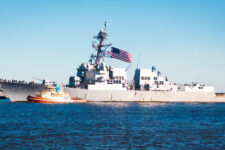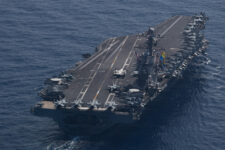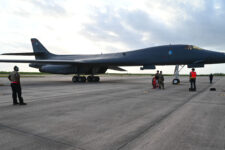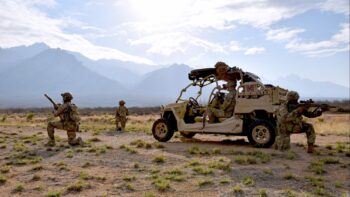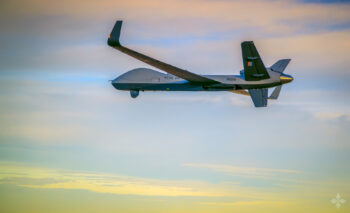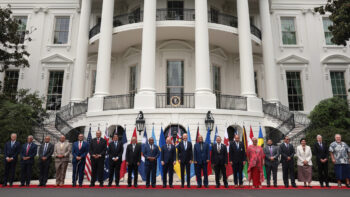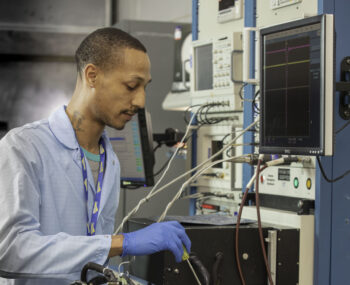
Undersecretary of the Navy Erik Raven testifies before the Senate Armed Services Committee on military recruiting challenges, Washington, D.C., March 22, 2023. (US Air Force photo by Eric Dietrich)
WASHINGTON — Erik Raven stepped down from his job at the Pentagon this past August, but he still has a lot to say about the US Navy.
And just this week, his new employer, the Washington, DC-based strategic advisory firm Beacon Global Strategies, reached out to Breaking Defense to sit down with the former under secretary for a wide-ranging discussion about everything from AUKUS to unmanned systems.
With two decades as a staffer in the Senate and just over two years as the Navy’s second most senior civilian, his arrival in the private sector is a significant change of pace. Sitting at a quaint café in northwest DC, just a few blocks from the White House, he was dressed comfortably in a suit with no tie, and lacking the usual entourage of aides, staffers and security guards that routinely shadow the Pentagon’s top leadership.
He said since leaving his post as the under, he’s been thinking about the Navy’s operations in the Red Sea and the Mediterranean. While Raven appreciates the laudatory coverage given to the sailors who have conducted those operations, he said, in his view, there is something missing in the conversation.
“What we’re seeing today in the Red Sea could be replicated in many other regions and key critical straits and nodes across the world,” he explained. “And so, I think taking apart what naval capabilities are bringing to that region today can be very instructive in how future conflicts may play out.”
The following is a continuation of Breaking Defense’s conversation with Erik Raven. This interview has been edited for length and clarity.
BREAKING DEFENSE: I’m sure you’ve seen the public discussions around the issue of the Navy using $1 million missiles to defeat drones that are worth a fraction of that cost. Is there a nuance the public doesn’t understand in this cost equation, or does the Navy just not have a better solution yet?
ERIK RAVEN: There are probably a couple dimensions of this. One is the cost exchange. Everybody is right to be concerned about how much a missile costs that is defeating a drone that might cost $50 or $100,000 that’s being used to threaten commercial shipping.
I would say the cost calculation that needs to be added to that $2 million missile against a $100,000 drone, [is that we’re] defending a ship or some other asset that may be worth hundreds of millions or perhaps even a billion dollars, depending what cargo it’s carrying. So, that has to enter the equation somehow.
There are many promising technologies that could alter the balancing power on this exchange question, but I think a little peek into the operational context is also important here. The main reason we’re using long-range interceptors to defeat these threats is because we don’t want them to be within several kilometers [of] either a Navy ship carrying several hundred sailors or a commercial ship carrying hundreds of millions of dollars worth of cargo. Directed energy has a lot of promise, but right now it’s a short-range solution. Do you really want to have that threat be so close to the target before you can prosecute it?
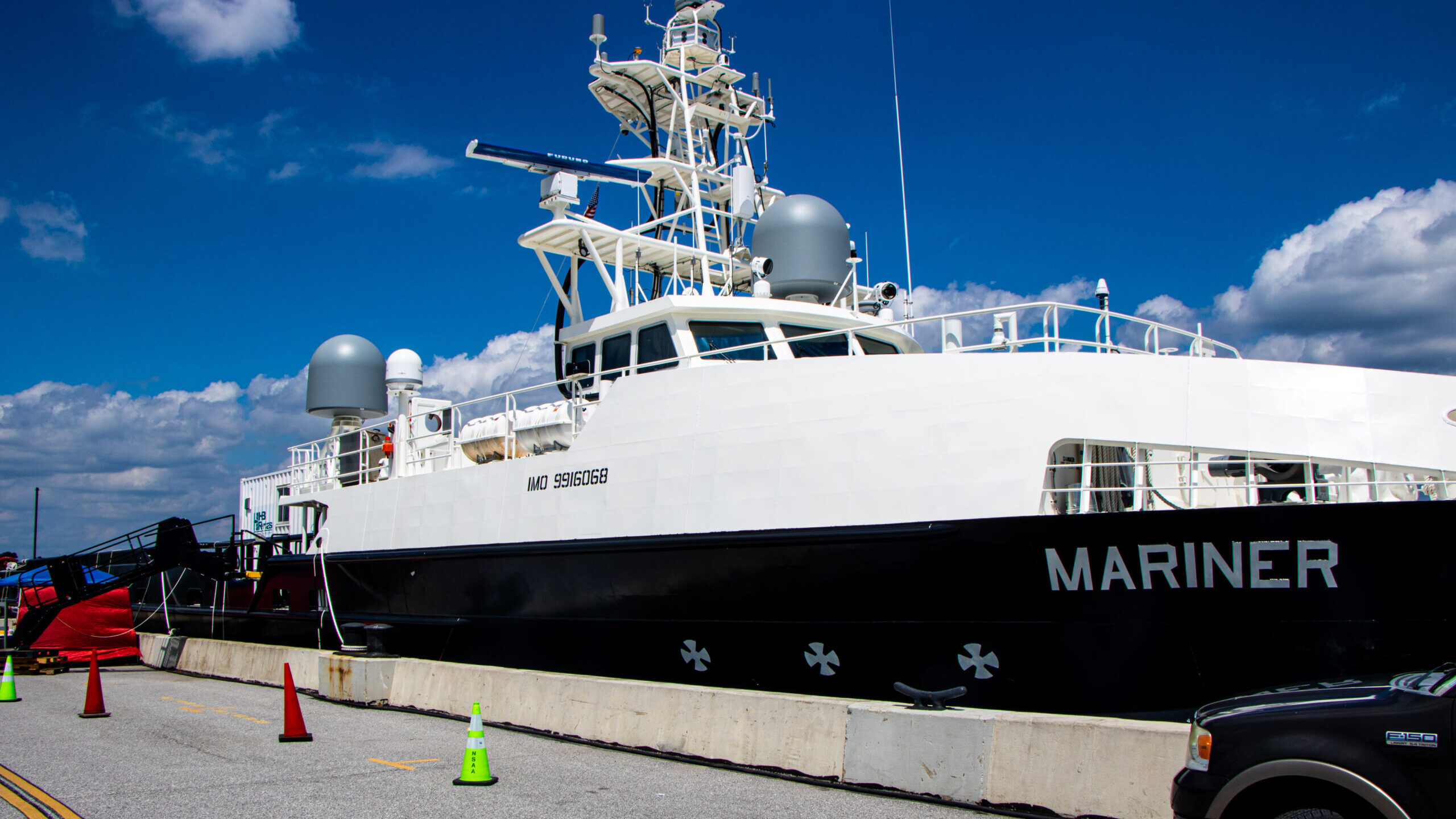
The USV Mariner, a US Navy research and development vessel, docked at the United States Naval Academy where it will be christened on Aug. 23, 2022. (Justin Katz/Breaking Defense)
Let’s talk about another emerging technology. The Navy for several years now has been pitching Congress on the use of unmanned and autonomous systems to varying degrees of success. Do you think the Navy’s pitch is landing with Congress or are things getting lost in translation?
I would say that this is broader than Navy and congressional discussion. I think it’s really about the Joint Force and where unmanned and autonomous technologies fit into present operations and future operations. I recall very well being in Congress, perhaps it was 10 years ago, when there was a lot of discussion about future aircraft. Do they really need to be manned? That autonomy is right around the corner.
And if we look back to how far autonomy has advanced in the last 10 years, I think most people would say that’s a good conversation to have, but maybe at the time, it was a little premature. Autonomy is advancing. But do we have autonomy to the point where it can replace not only human capabilities to fuse information, often aided by AI and other exquisite technologies, but also make life or death decisions? I think we’re still at the cusp of a really robust debate about not only what the technology can do, but what policy makers and the American public is comfortable with in terms of autonomous systems making very important decisions.
You announced during the budget rollout the Navy is aiming to hit its two-submarines-per-year delivery cadence by 2028. It’s an ambitious goal given the service’s history on this subject and will be crucial to make AUKUS’s first pillar a success. What’s the biggest hurdle to making it happen?
I think that what we’re seeing now is challenges in the supply chain and challenges in workforce as the two top items that the Navy is really tracking [and] trying to tackle.
All credit to Congress that several years ago, even before it was built into Navy budgets, leaders in Congress were aware of the strain that was facing the submarine industrial base and started putting in hundreds of millions of dollars annually to get the suppliers up and running. I think that there has been really good progress made so far in terms of expanding the number of suppliers [and] attracting new entrants.
On workforce, I think the underlying challenge here is that many Americans have a changing relationship with work, that they have different expectations of a career. They may have more interest in not staying with one company for their whole career, but moving around, maybe even between different industries.
There’s going to be a continuing dialog [between Navy and industry] on not only how to attract workers and train them, but how to keep them interested in the submarine industrial base for the long term. The reason why that’s so important is because if you’re training a welder or an electrician or a pipe fitter every couple of years, they don’t get that rich experience and productive capability that a journeyman or master welder has. That saves time, that saves money. That sort of experience is what puts the whole program on a better cadence to deliver for the national security goals.

(Left to right) Australia Defense minister Richard Marles, UK Secretary of State for Defence John Healey and US Defense Secretary Llyod Austin kick off the third in-person AUKUS defense ministerial meeting at the Old Royal Naval College on Sept. 26. (Breaking Defense/ Ashley Roque)
What has struck me about AUKUS’s second pillar is that it seems as though a lot of people are talking about inviting new countries to join the agreement. But most of the people extending invitations are not actually the power brokers with the authority to do it. What’s your sense of things inside the government? Is there an enthusiasm for other nations to join Pillar II?
Let me separate the two issues. First is AUKUS, especially in regard to Pillar II. The objectives of that, as announced, are really to join with our two closest allies and create a defense innovation ecosystem that’s going to tackle some of the hardest but most promising technologies that we see that make a difference for military capabilities.
That is kind of a prelude to a much larger discussion that I think is kicking off right now, and that is, how do we join with our allies and partners in creating defense ecosystems that serve all our national security needs?
How do our allies and partners contribute to the needs of not only our national security, but their national security? I think what we’re seeing is a greater exploration of what it means to have an integrated and robust defense innovation ecosystem that includes our allies and partners, and it’s going to be an interesting policy discussion moving forward about how to reconcile the interest to make sure that we have a strong American industrial base with the fact that we have allies and partners who also need their own armaments and systems.
America’s greatest adversary? Kamala Harris says Iran is ‘an obvious’ answer
Analyst Becca Wasser told Breaking Defense the vice president’s answer may not “comport” with the current Pentagon strategy but reflects the reality of the shorter-term geopolitical landscape.


